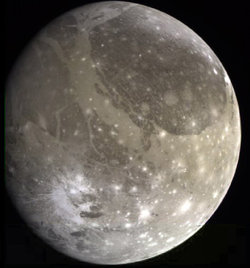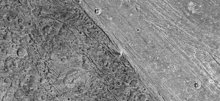Ganymede (moon)
|
|
| Click image for description | |||||||
| Discovery | |||||||
|---|---|---|---|---|---|---|---|
| Discovered by | G. Galilei S. Marius | ||||||
| Discovered on | January 11, 1610 | ||||||
| Orbital characteristics | |||||||
| Mean radius | 1,070,400 km (0.007155 AU) | ||||||
| Eccentricity | 0.0011 | ||||||
| Periastron | 1,069,200 km (0.007147 AU) | ||||||
| Apastron | 1,071,600 km (0.007163 AU) | ||||||
| Revolution period | 7.15455296 d (0.019588 a) | ||||||
| Orbital circumference | 6,725,500 km (0.045 AU) | ||||||
| Orbital velocity | max: 10.892 km/s mean: 10.880 km/s min: 10.868 km/s | ||||||
| Inclination | 25.56° (to the ecliptic) 0.20° to Jupiter's equator) | ||||||
| Is a satellite of | Jupiter | ||||||
| Physical characteristics | |||||||
| Mean diameter | 5262.4 km (0.413 Earths) | ||||||
| Surface area | 87 million km2 (0.171 Earths) | ||||||
| Volume | 7.6 × 1010 km3 (0.0704 Earths) | ||||||
| Mass | 1.4819×1023 kg (0.025 Earths) | ||||||
| Mean density | 1.942 g/cm3 | ||||||
| Surface gravity | 1.43 m/s2 (0.146 g) | ||||||
| Escape velocity | 2.7 km/s | ||||||
| Rotation period | synchronous | ||||||
| Axial tilt | zero | ||||||
| Albedo | 0.43 | ||||||
| Surface temp. |
| ||||||
| Atmospheric characteristics | |||||||
| Atmospheric pressure | trace | ||||||
| Oxygen | 100% | ||||||
Ganymede (gan'-i-meed, Greek Γανυμήδης) is Jupiter's largest moon, and indeed the largest moon in the entire solar system; it is larger in diameter than Mercury but only about half its mass. Ganymede is much larger than Pluto. It was discovered in 1610 by Galileo Galilei and named after the cup-bearer of the Greek gods, beloved of Zeus (see Ganymede (mythology)). It is alternately designated as Jupiter III. Although the name "Ganymede" was suggested by Simon Marius soon after its discovery, this name and the names of the other Galilean satellites curiously fell into disfavor for a considerable time, and were not revived in common use until the mid-20th century. In much of the earlier astronomical literature, it is simply referred to by its Roman numeral designation (a system Galileo used to snub Marius) as Jupiter III or as the "third satellite of Jupiter".
Physical characteristics
Ganymede is composed of silicate rock and water ice, with an ice crust floating over a slushy mantle that may contain a layer of liquid water. Preliminary indications from the Galileo orbiter data suggest that Ganymede is differentiated into a three layer structure: a small molten iron or iron/sulfur core surrounded by a rocky silicate mantle with an icy shell on top. This metallic core suggests a greater degree of heating at sometime in Ganymede's past than had previously been proposed. In fact, Ganymede may be similar to Io with an additional outer layer of ice.
Ganymede's surface is a roughly equal mix of two types of terrain: very old, highly cratered dark regions and somewhat younger (but still ancient) lighter regions marked with an extensive array of grooves and ridges. Their origin is clearly of a tectonic nature; Ganymede's crust appears to be divided into separate plates which, like Earth's tectonic plates, are able to move independently and interact along fracture zones producing mountain ranges. Features reminiscent of old lava flows have also been observed. In this respect, Ganymede may be more similar to the Earth than either Venus or Mars (though there is no evidence of recent tectonic activity). Similar ridge and groove terrain is seen on Enceladus, Miranda and Ariel. The dark regions are similar to the surface of Callisto.
Extensive cratering is seen on both types of terrain. The density of cratering indicates an age of 3 to 3.5 billion years, similar to the Moon. Craters both overlay and are cross cut by the groove systems indicating that the grooves are quite ancient, too. Relatively young craters with rays of ejecta are also visible. Unlike the Moon, however, the craters are quite flat, lacking the ring mountains and central depressions common to craters on the Moon and Mercury. This is probably due to the relatively weak nature of Ganymede's icy crust which can flow over geologic time and thereby soften the relief. Ancient craters whose relief has disappeared leaving only a "ghost" of a crater are known as palimpsests.
The largest feature on Ganymede is a dark plain named Galileo Regio, as well as a series of concentric ridges that are remnants of an ancient impact crater long since obscured by subsequent geological activity.
Evidence for a tenuous oxygen atmosphere on Ganymede, very similar to the one found on Europa, has been found recently by the Hubble Space Telescope. Note that this is not necessarily evidence of life; it is thought that the oxygen is produced when water ice on Ganymede's surface is split into hydrogen and oxygen by radiation and then the hydrogen is lost due to its low atomic mass.
The Galileo orbiter's first flyby of Ganymede discovered that Ganymede has its own magnetosphere field embedded inside Jupiter's huge one. This is probably generated in a similar fashion to the Earth's: as a result of motion of conducting material in the interior. It is thought that this conductive material may be a layer of liquid water with a high salt concentration, or it may originate in Ganymede's metallic core. Ganymede is the only moon known to have a magnetosphere.
Ganymede in fiction
- Robert Heinlein's novel Farmer in the Sky depicts the terraforming and colonization of Ganymede.
- In the science fiction TV series Babylon 5, the Shadows bury a ship under the surface of Ganymede, which is dug up during the third season of the show (the Messages From Earth episode).
- In Arthur C. Clarke's novel 2061: Odyssey Three, Ganymede is warmed by the new sun Lucifer and contains a large equatorial lake. It is the centre of human colonization of the Jovian system.
- The Gentle Giants of Ganymede by James P. Hogan ISBN 0345314697. An alien spaceship is found on Ganymede.
- In the 32nd Millennium of the Warhammer 40,000 Universe, Ganymede is destroyed during a Warp Core experiment that goes horribly awry.
- Ganymede is mentioned several times and visited by characters in the anime series Cowboy Bebop.
- In the Power Rangers TV series, Ganymede is the hiding place chosen by Zordon has the hiding space for a fleet of Zords known as the Mega Vehicles, which combine to form the Mega Voyager. The Space Rangers locate these Zords after winning Key Cards from Darkonda in a card game. ("Flashes of Darkonda", "The Rangers' Mega Voyage").
- In the anime Cowboy Bebop, Ganymede is depicted as a terraformed world that is entirely covered in water. Animal life, most likely created by human intervention is also depicted, such as the Ganymede searat, a species of rodent-like seal. About 7 million people live on it in floating colonies.
See also
| Jupiter's natural satellites edit (https://academickids.com:443/encyclopedia/index.php?title=Template:Jupiter_Footer&action=edit) |
|---|
| Metis | Adrastea | Amalthea | Thebe | Io | Europa | Ganymede | Callisto | Themisto | Leda | Himalia | Lysithea | Elara | S/2000 J 11 | Carpo | S/2003 J 12 | Euporie | S/2003 J 3 | S/2003 J 18 | Thelxinoe | Euanthe | Helike | Orthosie | Iocaste | S/2003 J 16 | Ananke | Praxidike | Harpalyke | Hermippe | Thyone | Mneme | S/2003 J 17 | Aitne | Kale | Taygete | S/2003 J 19 | Chaldene | S/2003 J 15 | S/2003 J 10 | S/2003 J 23 | Erinome | Aoede | Kallichore | Kalyke | Eurydome | S/2003 J 14 | Pasithee | Cyllene | Eukelade | S/2003 J 4 | Hegemone | Arche | Carme | Isonoe | S/2003 J 9 | S/2003 J 5 | Pasiphaë | Sinope | Sponde | Autonoe | Callirrhoe | Megaclite | S/2003 J 2 |
| Amalthea group | Galilean moons | Himalia group | Ananke group | Carme group | Pasiphaë group |
ca:Ganimedes (satèl·lit) de:Ganymed (Mond) eo:Ganimedo es:Ganímedes (luna) fr:Ganymède (lune) ko:가니메데 (위성) it:Ganimede (astronomia) he:גאנימד la:Ganymedes (satelles) nl:Ganymedes (maan) ja:ガニメデ pl:Ganimedes (księżyc) pt:Ganímedes (satélite) fi:Ganymedes sr:Ганимед sv:Ganymedes (måne) zh:木卫三


